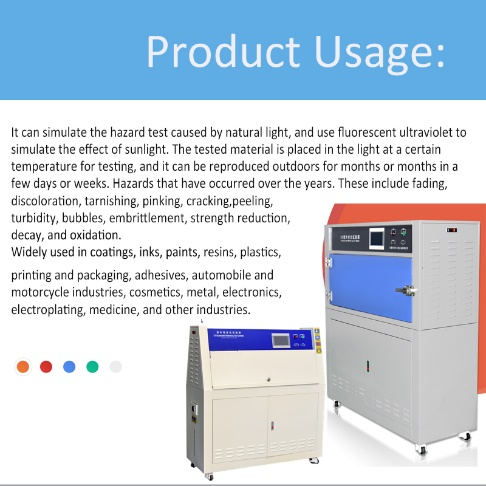The UV weather aging test chamber is another kind of photoaging test equipment that simulates the light in the sunlight. It can also reproduce the damage caused by rain and dew. The equipment is tested by exposing the material to be tested in the controlled interactive cycle of sunlight and humidity and increasing the temperature. The equipment uses ultraviolet fluorescent lamps to simulate the sun, and can also simulate the moisture effect by condensation or spray.
It takes only a few days or weeks for the device to reproduce the damage that takes months or years to be outdoors. The damage mainly includes discoloration, discoloration, brightness decrease, pulverization, cracking, fuzziness, embrittlement, strength decrease, and oxidation. The test data provided by the equipment can be helpful to the selection of new materials, the improvement of existing materials, or the evaluation of composition changes that affect the durability of products. The equipment can predict the changes the product will encounter outdoors.
Although UV only accounts for 5% of the sunlight, it is the main factor that causes the durability of outdoor products to decline. This is because the photochemical reaction of sunlight increases with the decrease of wavelength. Therefore, when simulating the damage of sunlight on the physical properties of materials, it is not necessary to reproduce the whole sunlight spectrum. In most cases, you only need to simulate the UV light of a short wave. The reason why UV lamp is used in UV accelerated weather tester is that they are more stable than other tubes and can reproduce the test results better. It is the best way to simulate the effect of sunlight on physical properties by using fluorescent UV lamps, such as brightness drop, crack, peeling, and so on. There are several different UV lights available. Most of these UV lamps produce ultraviolet light, not visible and infrared light. The main differences of lamps are reflected in the difference in the total UV energy produced in their respective wavelength range. Different lights will produce different test results. The actual exposure application environment can prompt which type of UV lamp should be selected.
UVA-340, the best choice for simulating sunlight ultraviolet rays
UVA-340 can simulate the solar spectrum in the critical short wave wavelength range, that is, the spectrum with a wavelength range of 295-360nm. UVA-340 can only produce the spectrum of UV wavelength that can be found in the sunlight.
UVB-313 for the maximum acceleration test
UVB-313 can provide the test results quickly. They use shorter wavelength UVs that are stronger than those found on earth today. Although these UV lights with much longer than the natural waves can accelerate the test to the greatest extent, they will also cause inconsistent and actual degradation damage to some materials.
The standard defines a fluorescent ultraviolet lamp with the emission of less than 300nm less than 2% of the total output light energy, usually called UV-A lamp; a fluorescent ultraviolet lamp with the emission energy below 300nm is greater than 10% of the total output light energy, usually called UV-B lamp;
The UV-A wavelength range is 315-400nm, and UV-B is 280-315nm;
The time for materials exposed to moisture outdoor can reach 12 hours a day. The results show that the main reason for this outdoor humidity is dew, not rain. The UV accelerated weather resistance tester simulates the moisture effect outdoor by a series of unique condensation principles. In the condensation cycle of the equipment, there is a water storage tank at the bottom of the box and heated to generate water vapor. The hot steam keeps the relative humidity in the test chamber at 100 percent and maintains a relatively high temperature. The product is designed to ensure that the test specimen actually forms the sidewall of the test chamber so that the back of the test piece is exposed to indoor ambient air. The cooling effect of indoor air causes the surface temperature of the test piece to drop to a level several degrees lower than the steam temperature. The appearance of this temperature difference leads to the liquid water produced by condensation on the surface of the specimen during the whole condensation cycle. This condensate is a very stable purified distilled water. Pure water improves the reproducibility of the test and avoids the problem of water stains.
Because the exposure time of outdoor exposure to humidity can be up to 12 hours a day, the humidity cycle of UV accelerated weather resistance tester generally lasts for several hours. We recommend that each condensation cycle last at least 4 hours. Note that UV and condensation exposure in the equipment are carried out separately and are consistent with the actual climate conditions.
For some applications, water spray can better simulate the final use of environmental conditions. Water spray is very use

Post time: Nov-15-2023

